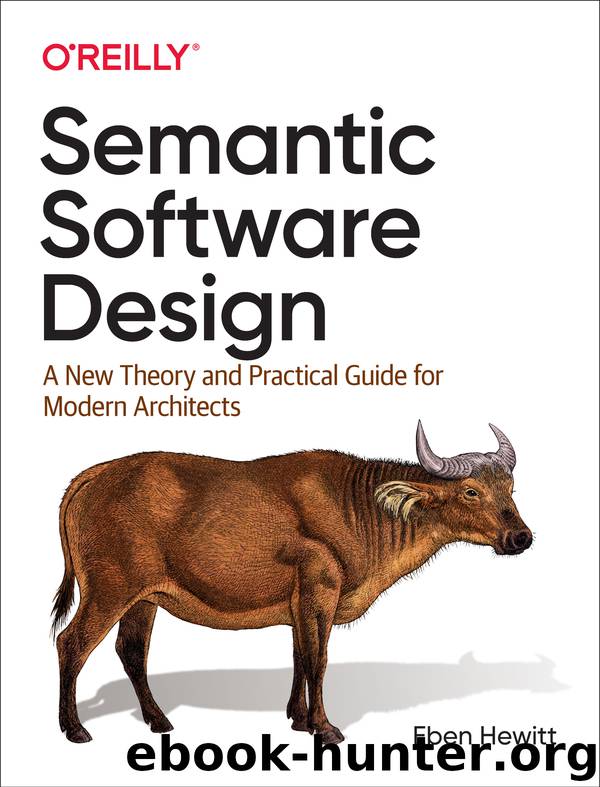Semantic Software Design by Eben Hewitt

Author:Eben Hewitt
Language: eng
Format: epub
Publisher: O'Reilly Media
Published: 2019-10-01T16:00:00+00:00
Eventing
The most basic form of asynchronous processing is publisher/subscriber, or pub/sub. One component, the event producer, publishes an event to a queue or topic. A queue, here, stores that event and allows it to be read asynchronously by a single separate second component (the subscriber). A topic is like a queue that allows multiple subscribers to pick up the event.
The idea of publishing events to topics is a crucial one in deconstructed design. Fundamentally, the fact that there are multiple event subscribers, and they are free to come and go (subscribe and unsubscribe), free to process the event in their own time, in some way unbeknownst to the event producer, is a perfect vehicle for many of the concepts we’re working with. Because we know that we don’t know what something will mean, because we know that we don’t know the “correct” response (or assume that there is only one of them), and because we want to design systems to be incredibly scalable, pub/sub eventing fits the bill perfectly. It’s the architectural choice that makes the fewest assumptions about the world. It allows you the most scalability, flexibility, extensibility, loose coupling, and portability.
At the heart of this pattern is the event. Every event should be represented with the same idea: that there is a state change that just happened to this noun in the immediate past. In the hotel domain, for instance, you could conceive that “Guest Checked Out” is an important event. Others might be “Order Placed” or “Reservation Cancelled.” Notice that any human being who has ever stayed in a hotel is likely aware of these events. That’s the appropriate level for now: nontechnical, business oriented. Just take a few minutes to list out what some of the major and obvious events are in your domain.
When performing your domain analysis and representing your set of services as we discussed earlier in this chapter, take another pass through that work, viewing it through the lens of events. Examine each of your services and the ideas in your domain model and ask which of them can benefit from an event pattern. Just as you examined the domain model to ask how the verbs and nouns interact, consider too which services have strong associations with the events you have listed. This will lead you to some clear places where you can take advantage of events for the things they’re best at: loose coupling, perceived performance, scalability, extensibility, and portability.
Because managers run the orchestration of services, it is best to have the manager emit the significant events. The manager service places an event on a pub/sub topic so that multiple subscribers can respond, as shown in Figure 7-2.
Download
This site does not store any files on its server. We only index and link to content provided by other sites. Please contact the content providers to delete copyright contents if any and email us, we'll remove relevant links or contents immediately.
| Coding Theory | Localization |
| Logic | Object-Oriented Design |
| Performance Optimization | Quality Control |
| Reengineering | Robohelp |
| Software Development | Software Reuse |
| Structured Design | Testing |
| Tools | UML |
Deep Learning with Python by François Chollet(11894)
Hello! Python by Anthony Briggs(9373)
OCA Java SE 8 Programmer I Certification Guide by Mala Gupta(9343)
The Mikado Method by Ola Ellnestam Daniel Brolund(9307)
Dependency Injection in .NET by Mark Seemann(8859)
Algorithms of the Intelligent Web by Haralambos Marmanis;Dmitry Babenko(7852)
Test-Driven iOS Development with Swift 4 by Dominik Hauser(7323)
Grails in Action by Glen Smith Peter Ledbrook(7295)
The Well-Grounded Java Developer by Benjamin J. Evans Martijn Verburg(7116)
Secrets of the JavaScript Ninja by John Resig Bear Bibeault(5957)
Kotlin in Action by Dmitry Jemerov(4638)
Practical Vim (for Kathryn Amaral) by Drew Neil(3728)
Cracking the GRE Premium Edition with 6 Practice Tests, 2015 (Graduate School Test Preparation) by Princeton Review(3596)
Linux Device Driver Development Cookbook by Rodolfo Giometti(3416)
Learn Windows PowerShell in a Month of Lunches by Don Jones(3242)
Learning Java by Patrick Niemeyer & Daniel Leuck(2871)
Learning React: Functional Web Development with React and Redux by Banks Alex & Porcello Eve(2837)
Becoming a Dynamics 365 Finance and Supply Chain Solution Architect by Brent Dawson(2678)
Mastering Java 9 by Dr. Edward Lavieri(2573)
